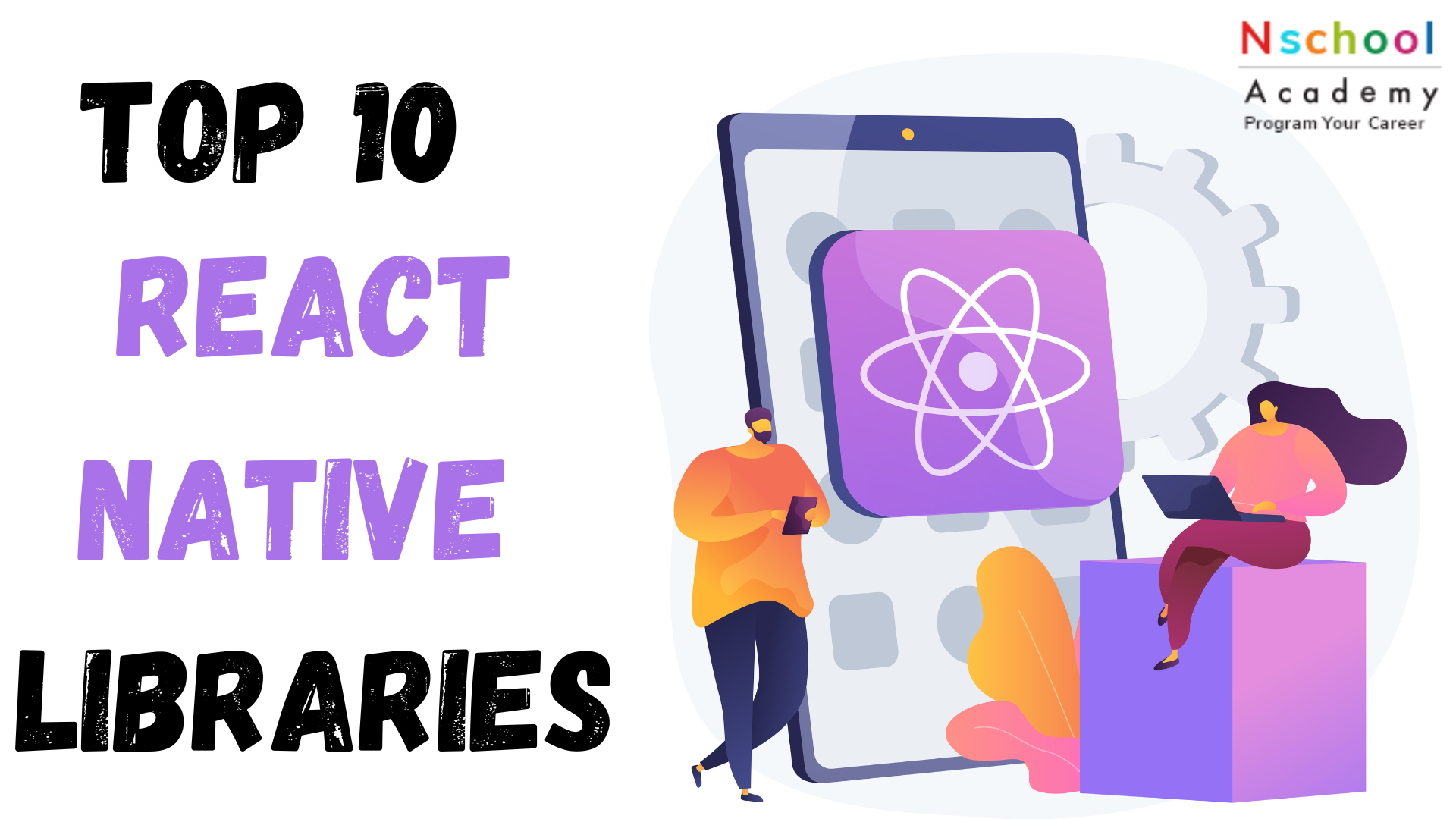Top 10 React Native Libraries
- July 20, 2024
- nschool
- 0

Introduction
React Native is well-known as the cross-platform framework for mobile application development which is written in JavaScript and based on React. For the creation of the apps and adding many possibilities to them, a lot of libraries are available. Further, let’s discuss the most valuable React Native libraries that will highly help you in the development process and improve your application.
React Native Libraries
1.React Navigation
React Navigation is very essential when it comes to managing navigation in your React Native applications. It allows for simple implementation of other types of navigation including the stack, tab, and drawer navigation that are widely used in most mobile applications.
Why It’s Useful: With the help of React Navigation, it becomes simple to go from one screen to another in an application. Whether you want to implement a basic tab-based navigation or a more complex, multi-level one, React Navigation provides all the tools. It also features deep linking, in such a way that when your app is accessed through a URL, it opens a specific screen in the app.
Features:
- It is very easy to install and you are not restricted when choosing the theme you want.
- Supports various navigation patterns.
- Helps to store and retrieve the navigation state of the application when it is relaunched.
2.Redux
Redux is an extremely powerful library built to handle the state of your application. In a React Native app, the state is the information that determines what is displayed to the user or what is active and available for the user to input. Redux assists in managing and predicting this data and makes your app controlled or easy to debug.
Why It’s Useful: As your application develops, managing state can become challenging as there are many ways to approach it. It gives you a single location through which to maintain your state and easily update and access it from across your application. It also integrates nicely with middleware, which can handle asynchronous actions as API requests.
Features:
- Centralized state management.
- Middleware support for action handling with asynchronous processes.
- Historical debugging, which lets you look more at how the state of the app is progressing over some time.
3. Axios
Axios is an HTTP Client library and that implies it is designed to assist an application to interact with a server to request/get or send data. It is more useful when you have many API calls, as it reduces the complexity of coding by grouping related functionality.
Why It’s Useful: Axios is particularly useful when it comes to handling basic functionalities, such as getting data from a remote server, sending data to a server, as well handling the responses. It also has built-in functionality to modify requests and responses, including errors and processing actions such as adding authorization tokens to requests.
Features:
- Asynchronous nature or support for asynchronous functions can be resolved using promises.
- This intercepts request and response operations.
- It simplifies error handling and setting default controls, reducing complexity in your code
4.Styled Components
The main idea of the Styled Components library is that it lets developers write the styles of components directly in JavaScript. This is good because you don’t have to write completely new CSS files for styled components which may lead to keeping the code cleaner and less likely to get messy.
Why It’s Useful: It makes it easier to handle styles in a more modular and reusable manner by utilizing styles through Styled Components. It enables you to design styles that depend on the props and theme, which enhances consistency and easy to adjust the appearance of the application.
Features:
- Strip them down to the component level, making sure that the styles only apply to certain parts of your app.
- With theme support, we are certain that our app will always have a standard layout for every component and all screens of the interface will be styled the same.
- True dynamic styling where the styling of the components depends on the props passed in by the user.
5. React Native Paper
React Native Paper can therefore be described as a library that offers a set of fully customizable components with design references to material design. It helps you create good and well-aligned UIs easily and smoothly.
Why It’s Useful: React Native Paper provides you with vast libraries of already designed widgets such as buttons, cards, dialogs, and many others that can make your work easier and give your app a professional look. It also supports theming, making it easier to set off the same look and feel throughout the whole application.
Features:
- Rich set of components.
- It has primarily been developed in compliance with Material Design for the UI elements and components.
- Theming to help those enticing customers for an easy fix.
6.React Native Vector Icons
React Native Vector Icons are used to give an extensive list of icons that can be customizable for concrete applications in React Native. Some of the points that have been established regarding icons include; Icons are an essential aspect of the apps in question since they offer visuals and enrich the user experience.
Why It’s Useful: This library provides numerous icons from the most famous icon sets, so if one finds an icon set that fits the design of the app, the process of obtaining it is seamless. For instance, the size, color, and design traits of the icon can be made in harmony with the general design of an app.
Features:
- Large collection of icons.
- Compatible with other libraries such as React Navigation in a very seamless manner.
- STYLES – what styles are there? – SELECTIVE COMPOSITES – Customizable styles and scalable vector graphics (SVGs) enhance flexibility and visual appeal in your application design.
7.Jest
Jest is a JavaScript testing framework supported by Facebook, and it is compatible with React Native. You can write and execute tests with it to check how your application responds to actions.
Why It’s Useful: It is exceedingly important to test your work to guarantee the stable functioning of your application. Jest allows for creating unit Tests, Snapshot Tests, and Integration Tests and is valuable for preventing and finding bugs and making sure the application is functioning as it should.
Features:
- Test cascading to obtain a snapshot view of the results of components.
- Highly versatile mocking library designed to work with functions and modules effectively and efficiently.
- This is a great tool because it gives you information about the areas in your code that do not have test coverage.
8.React Native CLI
The React Native CLI is a straightforward command-line interface that facilitates the creation, building, and running of projects with React Native. It offers smooth development right from the design to coding and it links well with other development enablers.
Why It’s Useful: Many people familiar with the CLI know that using it is quite easy to start a new project, test their application on various platforms, or debug it. It also includes the commands to create library links and upgraded projects, among others.
Features:
- Project setup and configuration.
- Build and run commands of this application on the various platforms used.
- Angular: Integration with development libraries.
9.React Native Reanimated
It is the new powerful library called React Native Reanimated designed to create highly responsive and complex animations in your RN apps. Animations enhance the user interface since it becomes easy for users to interact through an animated interface.
Why It’s Useful: Reanimated allows the creation of really effective animations that operate on the native thread, so the performance will be at its best. It is good for supporting complex animations and gestures, which would enhance user interactions, making it perfect for the job.
Features:
- Local animation driver for fluid animations.
- Extensive animation library.
- Capabilities for complex animations by using hand gestures.
10.React Native Gesture Handler
The GG version of this component makes handling touch gestures in any of your React Native applications easier. Consumers benefit from enhanced performance and input control of hand movements about gestures.
Why It’s Useful: It helps to improve the touch handling system of this library by simplifying the employment of some touch functions such as Swipes, Pinch, and Pan among others. It also can navigate libraries with great response, and gesture interactions are smooth.
Features:
- Imperative API for creating gestures.
- Native gesture recognition to increase performance.
- Easy to work with other navigation libraries used in React Native.
Conclusion
These are some of the React Native libraries that can prove very useful during the development of your React Native project. This way, it provides a rich set of features and automates a majority of frequently used operations so you can work on creating highly functional and efficient mobile applications. Incorporating these React Native libraries in your projects can lead to a better quality of code, enhanced development processes, as well as applications with great usability.

